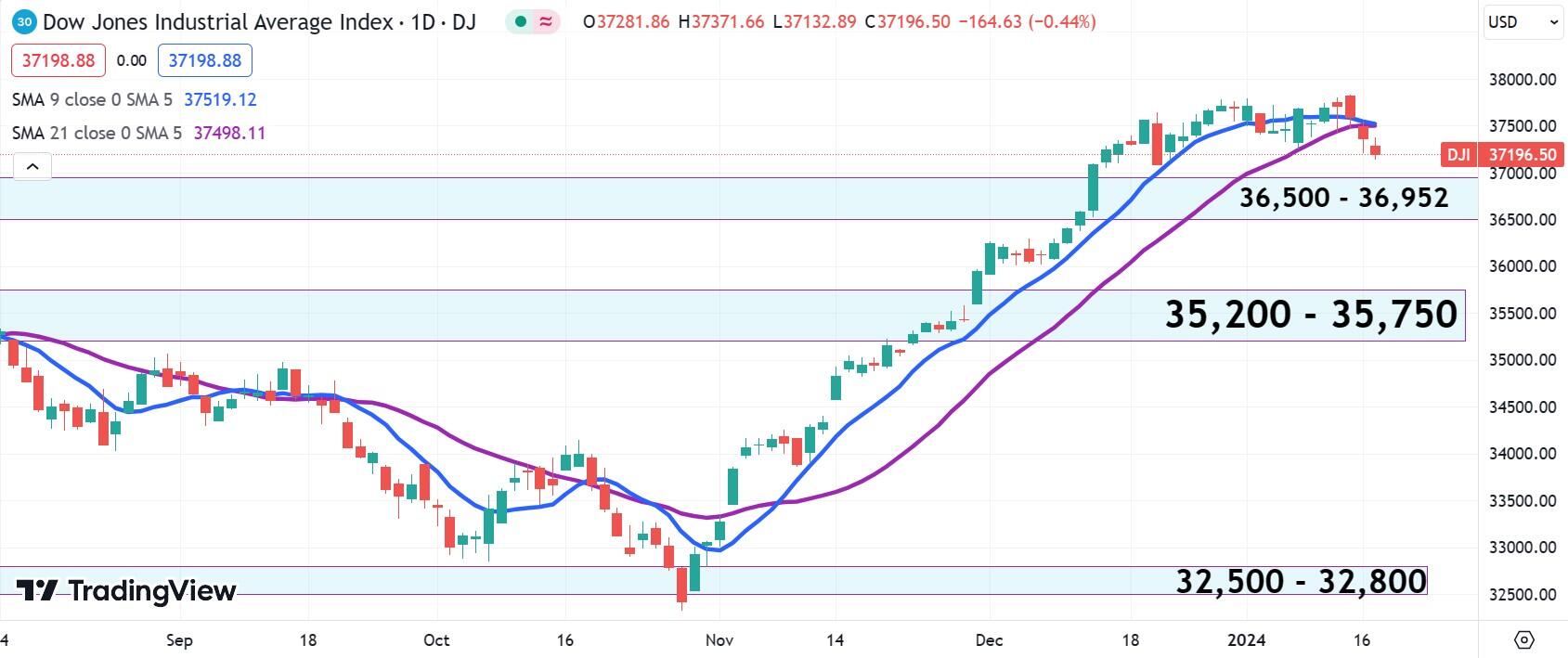- US Treasury yields rise again as rate cut expectations fade.
- US retail sales data for December was bullish.
- The Dow Jones Industrial Average closed below the 21-day simple moving average on Tuesday for the first time since Nov. 1.
- JPMorgan, UnitedHealth and Goldman Sachs report positive earnings, Travelers reports Friday.
He Dow Jones Industrial Average (DJIA) index lost value for the third consecutive session on Wednesday. The DJIA fell 0.25% on Wednesday, which was better than the 0.56% and 0.59% for the S&P 500 and the Nasdaq Composite, respectively. The fall had been much worse at the beginning of the session.
The release of US retail sales data for December surpassed consensus early on Wednesday, adding more negativity along with recent hawkish statements from Fed governors to suggest that the Federal Reserve (Fed) rate cut could take longer than expected.
After closing, Alcoa (AA) reported a loss of $150 million in the fourth quarter, with profits down 2.5% year over year. Dow Jones futures are also trading lower as the calendar turns to Thursday. Now stock investors will wait for initial jobless claims data that arrives an hour before the open.
Dow Joens investors have already digested three fourth-quarter earnings results from its constituents and are looking forward to Friday's earnings call. Travelers (TRV).
Dow Jones News: Markets Lower Expectations for Rate Cuts in March, May
The US Census Bureau reported that US retail sales in December rose 0.6% month-over-month. The consensus forecast growth of 0.4%, while the November figure had been 0.3%.
This data was too bullish for investors, who sold their shares directly. It was yet another example of how the market treats positive economic news as bad for stock prices. This is because investors believe that positive economic numbers reduce the likelihood that the Fed will begin cutting interest rates.
Before the release, the market was largely betting on cuts at both the March and May meetings of the Federal Open Market Committee (FOMC). But after U.S. retail sales, the odds that the central bank will keep rates unchanged in the 5.25% to 5.50% range at the March meeting rose from 35% to 43%, according to data from the agency. CME Group's FedWatch tool. Likewise, the odds that the federal funds rate will be 50 basis points below the current level (4.75% to 5.00%) at the May FOMC meeting fell from 59% to 15%.
Tuesday's comments from Fed Governor Christopher Waller also didn't help sentiment. Waller said there was no need for the central bank to cut rates at a precipitous pace and should instead take a wait-and-see approach. These comments were in line with December's “dot plot,” which called for 75 basis point cuts in 2024. The market soared in December on consensus market expectations of 150 basis points of cuts, and now that optimism It is moderating.
The fact that stock models are forecasting fewer rate cuts this year means that US Treasuries are selling off, pushing yields higher. On Wednesday, for the second day in a row, yields rose more than 2%. The 2-year bond yield even rose as much as 3% at one point during the session. Of course, the rise in yields usually goes in the opposite direction to that of stock prices, as is the case here.
The Dow Jones is unable to benefit from the recent gains of the index components
The Dow Jones index only has 30 stocks, so each component's earnings announcement often has a disproportionate effect. The start of this earnings season has been overshadowed by the total focus on interest rates, but three of the index's largest holdings have reported fourth-quarter results.
JPMorgan (JPM) started last Friday with adjusted earnings per share (EPS) of $3.97, up from $3.57 a year ago and beating consensus expectations of $3.61. Earnings were $38.6 billion, more than $1.2 billion below consensus. Overall, profits were up nearly 12% from a year earlier, and the community banking division was praised for driving most of those gains.
UnitedHealth Group (UNH), which represents about 10% of the Dow Jones index and remains its largest holding, also released its fourth-quarter results last Friday. The insurer said healthcare costs rose more than expected in the quarter, but it was still able to beat consensus on EPS and earnings by a small margin. Profits increased 14% year-over-year, and the company once again reaffirmed its 2024 guidance.
Goldman Sachs (GS), which represents about 7% of the Dow Jones, absolutely smashed consensus estimates for the fourth quarter when it released its results on Tuesday. GAAP EPS of $5.48 beat analyst estimates by $1.55, and earnings consensus was beat by $360 million. Management praised its wealth management unit for better-than-expected results.
Analysts are not so optimistic about Travelers, a minor component of the Dow that reports on Friday. All 19 analysts who revised their estimates for the fourth quarter have cut their earnings outlooks. The commercial and property insurer is expected to post adjusted earnings of $5.06 on revenue of $9.95 billion.
Frequently Asked Questions About the Dow Jones
What is the Dow Jones?
The Dow Jones Industrial Average, one of the world's oldest stock indices, is made up of the 30 most traded securities in the United States. The index is weighted by price rather than capitalization. It is calculated by adding the prices of the securities that comprise it and dividing them by a factor, currently 0.152. The index was founded by Charles Dow, also founder of the Wall Street Journal. In recent years it has been criticized for not being sufficiently representative, as it only tracks 30 companies, unlike broader indices such as the S& P 500.
What factors influence the Dow Jones index?
There are many factors that drive the Dow Jones Industrial Average (DJIA). The main one is the aggregate performance of its component companies, revealed in quarterly corporate earnings reports. US and global macroeconomic data also contribute, influencing investor sentiment. The level of interest rates, set by the Federal Reserve (Fed), also influences the DJIA, as it affects the cost of credit, on which many companies largely depend. Therefore, inflation can be a determining factor, as well as other parameters that influence the decisions of the Federal Reserve.
What is the Dow theory?
The Dow Theory is a method for identifying the main trend of the stock market developed by Charles Dow. A key step is to compare the direction of the Dow Jones Industrial Average (DJIA) and the Dow Jones Transportation Average (DJTA) and only follow trends where both are moving in the same direction. Volume is a confirmation criterion. The theory uses elements of maximum and minimum analysis. The Dow theory proposes three phases of the trend: accumulation, when the smart money begins to buy or sell; public participation, when the general public joins the trend; and distribution, when the smart money abandons the trend.
How can I trade with the DJIA?
There are several ways to trade the DJIA. One of them is to use ETFs that allow investors to trade the DJIA as a single security, instead of having to buy shares of the 30 companies that comprise it. A prominent example is the SPDR Dow Jones Industrial Average ETF (DIA). Futures contracts on the DJIA allow traders to speculate on the future value of the index, and options provide the right, but not the obligation, to buy or sell the index at a predetermined price in the future. Mutual funds allow investors to purchase a portion of a diversified portfolio of DJIA securities, providing exposure to the global index.
Dow Jones Industrial Average Index Forecast
The Dow Jones Index fell below the 21-day SMA on Tuesday, and the index continued to do so on Wednesday. The DJIA has closed above the 21-day SMA in every session since November 1, so this is important and likely indicates that a bearish reversal is underway. It also appears that the DJIA is on a bearish move, as Wednesday's close has made a low lower than the January 8 low.
The DJIA could find support in the old resistance range of 36,500 to 36,952, which dates back to late 2021. However, a break of 36,500 would trigger a new sell-off that would likely head towards another former resistance zone located around the 35,500 points.
Dow Jones Industrial Average daily chart
Source: Fx Street
I am Joshua Winder, a senior-level journalist and editor at World Stock Market. I specialize in covering news related to the stock market and economic trends. With more than 8 years of experience in this field, I have become an expert in financial reporting.








